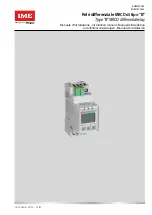
ABB Automation Inc.
Substation Automation and Protection Division
Coral Springs, FL 33065
Instruction Leaflet
All possible contingencies which may arise during installation, operation or maintenance, and all details and
variations of this equipment do not purport to be covered by these instructions. If further information is desired
by purchaser regarding this particular installation, operation or maintenance of this equipment, the local ABB
Power T&D Company Inc. representative should be contacted.
Effective:
December 1999
( | ) Denotes Change Since Previous Issue
Printed in U.S.A
.
ABB
ABB
ABB
ABB
41-971.3M
Type HCB-1
Pilot-wire Relay System
Supersedes I.L. 41-971.3L, Dated August 1996
!
CAUTION
Before putting protective relays into service,
remove all blocking which may have been
inserted for the purpose of securing the parts
during shipment, make sure that all moving
parts operate freely, inspect the contacts to
see that they are clean and close properly, and
operate the relay to check the settings and
electrical connections.
1.0 APPLICATION
The type HCB-1 relay is a high speed pilot-wire relay
designed for the complete phase and ground protec-
tion of two and three terminal transmission lines.
Simultaneous tripping of the relay at each terminal is
obtained in about 20 milliseconds for all faults. A
complete installation for a two terminal line consists
of two relays, two insulating transformers, and an
interconnecting pilot-wire circuit. For a three terminal
line, three relays, three insulating transformers, and a
wye-connected pilot-wire circuit with branches of
equal series resistance are required.
The HCB-1 and HCB relays are not compatible, since
the filter response is not the same.
2.0 CONSTRUCTION
The relay consists of a combination positive, nega-
tive, and zero phase sequence filter, a saturating aux-
iliary transformer, two full wave rectifier units, a polar
unit, a Zener clipper, and an indicating contactor
switch (ICS), all mounted in a single case. The exter-
nal equipment normally supplied with the relay con-
sists of an insulating transformer, a millimeter and
test switch.
2.1.
SEQUENCE FILTER
The sequence filter consists of a three-legged iron
core reactor and a set of resistors designated R
1
and
R
0
. The reactor has three windings; two primary and
a tapped secondary winding, wound on the center leg
of a “F” type of lamination. The secondary taps are
wired to the A, B and C tap connections in front of the
relay. R
0
consists of three tube resistors with taps
wired to the F, G and H tap connections in the front of
the relay.
2.2.
SATURATING TRANSFORMER
The output of the sequence filter connects to the pri-
mary of a two-winding saturating transformer. The pri-
mary winding is tapped and wired to a tap block T in
the front of the relay. The secondary winding is con-
nected to the Zener clipper circuit and from a fixed
tap to the relay coil circuits.
2.3.
POLAR UNIT
This unit consists of a rectangular-shape magnetic
frame, an electromagnet, a permanent magnet, and
an armature with either one or two contacts. The
poles of the crescent-shaped permanent magnet
bridge the magnetic frame. The magnetic frame con-
sists of three pieces joined in the rear with two brass
rods and silver solder. These non-magnetic joints
R
Summary of Contents for HCB-1
Page 19: ...Type HCB 1 Pilot Wire Relay System 41 971 3M 19 THIS SPACE RESERVED FOR NOTES ...
Page 21: ...Type HCB 1 Pilot Wire Relay System 41 971 3M 21 ...
Page 22: ...41 971 3M Type HCB 1 Pilot Wire Relay System 22 Figure 10 Typical HCB 1 Relay System ...
Page 23: ...Type HCB 1 Pilot Wire Relay System 41 971 3M 23 Sub 15 4810D98 ...
Page 27: ...Type HCB 1 Pilot Wire Relay System 41 971 3M 27 THIS PAGE RESERVED FOR NOTES ...


































